 |
 |
C o m m e m o r a t i v e
C o i n s |
||
| Germany | |||||||
The edge lettering of the German 2‐euro‐commemorative coins is : (Unity and justice and freedom) |
 |
||||||

|
 |
Germany | Mecklenburg‐Western Pomerania (Schwerin Castle) 2nd coin in the Federal States series |
20001 |  |
Volume : 31,245,630 Date of Issue : 02 Feb. 2007 Designer : Heinz Hoyer ("HH") Producer : German mints : Staatliche Münze Berlin in Berlin (mintmark = "A"), Bayerisches Hauptmünzamt in Munich (mintmark = "D"), Staatliche Münzen Baden‐Württemberg in Stuttgart (mintmark = "F"), Staatliche Münzen Baden‐Württemberg in Karlsruhe (mintmark = "G") or Landesbetrieb Hamburgische Münze in Hamburg (mintmark = "J") |
|||||

|
 |
Germany | 50th anniversary of the Signature of the Treaty of Rome | 20001 |  |
Volume : 30,865,630 Date of Issue : 25 Mar. 2007 Designer : Helmut Andexlinger Producer : German mints : Staatliche Münze Berlin in Berlin (mintmark = "A"), Bayerisches Hauptmünzamt in Munich (mintmark = "D"), Staatliche Münzen Baden‐Württemberg in Stuttgart (mintmark = "F"), Staatliche Münzen Baden‐Württemberg in Karlsruhe (mintmark = "G") or Landesbetrieb Hamburgische Münze in Hamburg (mintmark = "J") |
|||||

|
 |
Germany | Hamburg (St.‐Michaelis‐Church) 3rd coin in the Federal States series |
20001 |  |
Volume : 30,513,630 Date of Issue : 01 Feb. 2008 Designer : Erich Ott (Logo "Œ") Producer : German mints : Staatliche Münze Berlin in Berlin (mintmark = "A"), Bayerisches Hauptmünzamt in Munich (mintmark = "D"), Staatliche Münzen Baden‐Württemberg in Stuttgart (mintmark = "F"), Staatliche Münzen Baden‐Württemberg in Karlsruhe (mintmark = "G") or Landesbetrieb Hamburgische Münze in Hamburg (mintmark = "J") |
|||||

|
 |
Germany | 10 years of Economic and Monetary Union (EMU) | 20001 |  |
Volume : 30,565,630 Date of Issue : 02 Jan. 2009 Designer : Georgios Stamatopoulos ("ΓΣ") Producer : German mints : Staatliche Münze Berlin in Berlin (mintmark = "A"), Bayerisches Hauptmünzamt in Munich (mintmark = "D"), Staatliche Münzen Baden‐Württemberg in Stuttgart (mintmark = "F"), Staatliche Münzen Baden‐Württemberg in Karlsruhe (mintmark = "G") or Landesbetrieb Hamburgische Münze in Hamburg (mintmark = "J") |
|||||
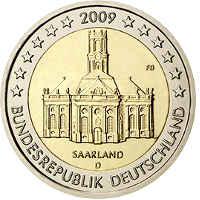
|
 |
Germany | Saarland (Ludwigs‐church in Saarbrücken) 4th coin in the Federal States series |
20001 |  |
Volume : 30,940,630 Date of Issue : 08 Feb. 2009 Designer : Friedrich Brenner Producer : German mints : Staatliche Münze Berlin in Berlin (mintmark = "A"), Bayerisches Hauptmünzamt in Munich (mintmark = "D"), Staatliche Münzen Baden‐Württemberg in Stuttgart (mintmark = "F"), Staatliche Münzen Baden‐Württemberg in Karlsruhe (mintmark = "G") or Landesbetrieb Hamburgische Münze in Hamburg (mintmark = "J") |
|||||

|
 |
Germany | Bremen (City Hall and Roland) 5th coin in the Federal States series |
20001 |  |
Volume : 30,925,630 Date of Issue : 29 Jan. 2010 Designer : Bodo Broschat (Logo "BB") Producer : German mints : Staatliche Münze Berlin in Berlin (mintmark = "A"), Bayerisches Hauptmünzamt in Munich (mintmark = "D"), Staatliche Münzen Baden‐Württemberg in Stuttgart (mintmark = "F"), Staatliche Münzen Baden‐Württemberg in Karlsruhe (mintmark = "G") or Landesbetrieb Hamburgische Münze in Hamburg (mintmark = "J") |
|||||
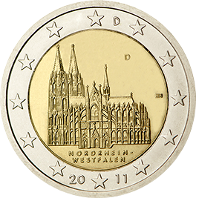
|
 |
Germany | North Rhine‐Westphalia (Cologne Cathedral) 6th coin in the Federal States series |
20001 |  |
Volume : 30,925,000 Date of Issue : 28 Jan. 2011 Designer : Heinz Hoyer ("HH") Producer : German mints : Staatliche Münze Berlin in Berlin (mintmark = "A"), Bayerisches Hauptmünzamt in Munich (mintmark = "D"), Staatliche Münzen Baden‐Württemberg in Stuttgart (mintmark = "F"), Staatliche Münzen Baden‐Württemberg in Karlsruhe (mintmark = "G") or Landesbetrieb Hamburgische Münze in Hamburg (mintmark = "J") |
|||||

|
 |
Germany | 10 years Euro‐Currency | 20001 |  |
Volume : 30,648,000 Date of Issue : 02 Jan. 2012 Designer : Helmut Andexlinger Producer : German mints : Staatliche Münze Berlin in Berlin (mintmark = "A"), Bayerisches Hauptmünzamt in Munich (mintmark = "D"), Staatliche Münzen Baden‐Württemberg in Stuttgart (mintmark = "F"), Staatliche Münzen Baden‐Württemberg in Karlsruhe (mintmark = "G") or Landesbetrieb Hamburgische Münze in Hamburg (mintmark = "J") |
|||||

|
 |
Germany | Bavaria (Neuschwanstein Castle) 7th coin in the Federal States series |
20001 |  |
Volume : 30,883,000 Date of Issue : 03 Feb. 2012 Designer : Erich Ott (Logo "Œ") Producer : German mints : Staatliche Münze Berlin in Berlin (mintmark = "A"), Bayerisches Hauptmünzamt in Munich (mintmark = "D"), Staatliche Münzen Baden‐Württemberg in Stuttgart (mintmark = "F"), Staatliche Münzen Baden‐Württemberg in Karlsruhe (mintmark = "G") or Landesbetrieb Hamburgische Münze in Hamburg (mintmark = "J") |
|||||

|
 |
Germany | 50 Year anniversary of the Élysée‐Treaty (Fanco‐German Friendship) Issued jointly by France and Germany |
20001 |  |
Volume : 11,585,000 Date of Issue : 22 Jan. 2013 Designer : Yves Sampo and Stefanie Lindner Producer : German mints : Staatliche Münze Berlin in Berlin (mintmark = "A"), Bayerisches Hauptmünzamt in Munich (mintmark = "D"), Staatliche Münzen Baden‐Württemberg in Stuttgart (mintmark = "F"), Staatliche Münzen Baden‐Württemberg in Karlsruhe (mintmark = "G") or Landesbetrieb Hamburgische Münze in Hamburg (mintmark = "J") |
|||||

|
 |
Germany | Baden‐Württemberg (Maulbronn Monastery) 8th coin in the Federal States series |
20001 |  |
Volume : 30,845,000 Date of Issue : 01 Feb. 2013 Designer : Eugen Ruhl (Logo "ER") Producer : German mints : Staatliche Münze Berlin in Berlin (mintmark = "A"), Bayerisches Hauptmünzamt in Munich (mintmark = "D"), Staatliche Münzen Baden‐Württemberg in Stuttgart (mintmark = "F"), Staatliche Münzen Baden‐Württemberg in Karlsruhe (mintmark = "G") or Landesbetrieb Hamburgische Münze in Hamburg (mintmark = "J") |
|||||
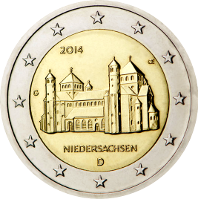
|
 |
Germany | Lower Saxony (St. Michael's church in Hildesheim) 9th coin in the Federal States series |
20001 |  |
Volume : 30,799,300 Date of Issue : 06 Feb. 2014 Designer : Erich Ott (Logo "Œ") Producer : German mints : Staatliche Münze Berlin in Berlin (mintmark = "A"), Bayerisches Hauptmünzamt in Munich (mintmark = "D"), Staatliche Münzen Baden‐Württemberg in Stuttgart (mintmark = "F"), Staatliche Münzen Baden‐Württemberg in Karlsruhe (mintmark = "G") or Landesbetrieb Hamburgische Münze in Hamburg (mintmark = "J") |
|||||

|
 |
Germany | Hesse (Paul's church in Frankfurt upon Main) 10th coin in the Federal States series |
20001 |  |
Volume : 30,767,100 Date of Issue : 30 Jan. 2015 Designer : Heinz Hoyer ("HH") Producer : German mints : Staatliche Münze Berlin in Berlin (mintmark = "A"), Bayerisches Hauptmünzamt in Munich (mintmark = "D"), Staatliche Münzen Baden‐Württemberg in Stuttgart (mintmark = "F"), Staatliche Münzen Baden‐Württemberg in Karlsruhe (mintmark = "G") or Landesbetrieb Hamburgische Münze in Hamburg (mintmark = "J") |
|||||

|
 |
Germany | 25th anniversary of German Reunification | 20001 |  |
Volume : 30,517,100 Date of Issue : 30 Jan. 2015 Designer : Bernd Wendhut ("BW") Producer : German mints : Staatliche Münze Berlin in Berlin (mintmark = "A"), Bayerisches Hauptmünzamt in Munich (mintmark = "D"), Staatliche Münzen Baden‐Württemberg in Stuttgart (mintmark = "F"), Staatliche Münzen Baden‐Württemberg in Karlsruhe (mintmark = "G") or Landesbetrieb Hamburgische Münze in Hamburg (mintmark = "J") |
|||||

|
 |
Germany | 30 years EU‐Flag | 20001 |  |
Volume : 30,125,000 Date of Issue : 05 Nov. 2015 Designer : Georgios Stamatopoulos ("ΓΣ") Producer : German mints : Staatliche Münze Berlin in Berlin (mintmark = "A"), Bayerisches Hauptmünzamt in Munich (mintmark = "D"), Staatliche Münzen Baden‐Württemberg in Stuttgart (mintmark = "F"), Staatliche Münzen Baden‐Württemberg in Karlsruhe (mintmark = "G") or Landesbetrieb Hamburgische Münze in Hamburg (mintmark = "J") |
|||||
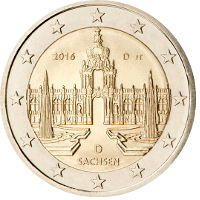
|
 |
Germany | Saxony (Zwinger Palace in Dresden) 11th coin in the Federal States series |
20001 |  |
Volume : 30,677,600 Date of Issue : 05 Feb. 2016 Designer : Jordi Truxa ("JT") Producer : German mints : Staatliche Münze Berlin in Berlin (mintmark = "A"), Bayerisches Hauptmünzamt in Munich (mintmark = "D"), Staatliche Münzen Baden‐Württemberg in Stuttgart (mintmark = "F"), Staatliche Münzen Baden‐Württemberg in Karlsruhe (mintmark = "G") or Landesbetrieb Hamburgische Münze in Hamburg (mintmark = "J") |
|||||
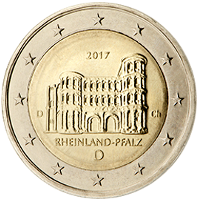
|
 |
Germany | Rhineland‐Palatinate (Porta Nigra in Trier) 12th coin in the Federal States series |
20001 |  |
Volume : 30,616,300 Date of Issue : 03 Feb. 2017 Designer : František Chochola ("Ch") Producer : German mints : Staatliche Münze Berlin in Berlin (mintmark = "A"), Bayerisches Hauptmünzamt in Munich (mintmark = "D"), Staatliche Münzen Baden‐Württemberg in Stuttgart (mintmark = "F"), Staatliche Münzen Baden‐Württemberg in Karlsruhe (mintmark = "G") or Landesbetrieb Hamburgische Münze in Hamburg (mintmark = "J") |
|||||

|
 |
Germany | Berlin (Charlottenburg Palace) 13th coin in the Federal States series |
20001 |  |
Volume : 36,636,500 Date of Issue : 30 Jan. 2018 Designer : Bodo Broschat (Logo "BB") Producer : German mints : Staatliche Münze Berlin in Berlin (mintmark = "A"), Bayerisches Hauptmünzamt in Munich (mintmark = "D"), Staatliche Münzen Baden‐Württemberg in Stuttgart (mintmark = "F"), Staatliche Münzen Baden‐Württemberg in Karlsruhe (mintmark = "G") or Landesbetrieb Hamburgische Münze in Hamburg (mintmark = "J") |
|||||

|
 |
Germany | 100th birthday of Helmut Schmidt | 20001 |  |
Volume : 30,621,000 Date of Issue : 30 Jan. 2018 Designer : Bodo Broschat (Logo "BB") Producer : German mints : Staatliche Münze Berlin in Berlin (mintmark = "A"), Bayerisches Hauptmünzamt in Munich (mintmark = "D"), Staatliche Münzen Baden‐Württemberg in Stuttgart (mintmark = "F"), Staatliche Münzen Baden‐Württemberg in Karlsruhe (mintmark = "G") or Landesbetrieb Hamburgische Münze in Hamburg (mintmark = "J") |
|||||

|
 |
Germany | 70 years of the Bundesrat (Prussian manor house in Berlin) 14th coin in the Federal States series |
20001 |  |
Volume : 30,507,300 Date of Issue : 29 Jan. 2019 Designer : Michael Otto (Logo "MO") Producer : German mints : Staatliche Münze Berlin in Berlin (mintmark = "A"), Bayerisches Hauptmünzamt in Munich (mintmark = "D"), Staatliche Münzen Baden‐Württemberg in Stuttgart (mintmark = "F"), Staatliche Münzen Baden‐Württemberg in Karlsruhe (mintmark = "G") or Landesbetrieb Hamburgische Münze in Hamburg (mintmark = "J") |
|||||

|
 |
Germany | 30th anniversary of the fall of the Berlin Wall Joint issue of Germany and France |
20001 |  |
Volume : 30,297,000 Date of Issue : 10 Oct. 2019 Designer : Joaquin Jimenez Producer : German mints : Staatliche Münze Berlin in Berlin (mintmark = "A"), Bayerisches Hauptmünzamt in Munich (mintmark = "D"), Staatliche Münzen Baden‐Württemberg in Stuttgart (mintmark = "F"), Staatliche Münzen Baden‐Württemberg in Karlsruhe (mintmark = "G") or Landesbetrieb Hamburgische Münze in Hamburg (mintmark = "J") |
|||||

|
 |
Germany | Brandenburg (Sanssouci Palace in Potsdam) 15th coin in the Federal States series |
20001 |  |
Volume : 30,567,500 Date of Issue : 28 Jan. 2020 Designer : Jordi Truxa (Logo "JT") Producer : German mints : Staatliche Münze Berlin in Berlin (mintmark = "A"), Bayerisches Hauptmünzamt in Munich (mintmark = "D"), Staatliche Münzen Baden‐Württemberg in Stuttgart (mintmark = "F"), Staatliche Münzen Baden‐Württemberg in Karlsruhe (mintmark = "G") or Landesbetrieb Hamburgische Münze in Hamburg (mintmark = "J") |
|||||

|
 |
Germany | 50th anniversary of the Warsaw kneeling | 20001 |  |
Volume : 30,350,000 Date of Issue : 08 Oct. 2020 Designer : Bodo Broschat (Logo "BB") Producer : German mints : Staatliche Münze Berlin in Berlin (mintmark = "A"), Bayerisches Hauptmünzamt in Munich (mintmark = "D"), Staatliche Münzen Baden‐Württemberg in Stuttgart (mintmark = "F"), Staatliche Münzen Baden‐Württemberg in Karlsruhe (mintmark = "G") or Landesbetrieb Hamburgische Münze in Hamburg (mintmark = "J") |
|||||

|
 |
Germany | Saxony‐Anhalt (Magdeburg Cathedral) 16th coin in the Federal States series |
20001 |  |
Volume : 30,433,900 Date of Issue : 26 Jan. 2021 Designer : Michael Otto (Logo "mo") Producer : German mints : Staatliche Münze Berlin in Berlin (mintmark = "A"), Bayerisches Hauptmünzamt in Munich (mintmark = "D"), Staatliche Münzen Baden‐Württemberg in Stuttgart (mintmark = "F"), Staatliche Münzen Baden‐Württemberg in Karlsruhe (mintmark = "G") or Landesbetrieb Hamburgische Münze in Hamburg (mintmark = "J") |
|||||

|
 |
Germany | Thuringia (Wartburg Castle) 17th coin in the Federal States series |
20001 |  |
Volume : 30,424,900 Date of Issue : 25 Jan. 2022 Designer : Olaf Stoy ("OS") Producer : German mints : Staatliche Münze Berlin in Berlin (mintmark = "A"), Bayerisches Hauptmünzamt in Munich (mintmark = "D"), Staatliche Münzen Baden‐Württemberg in Stuttgart (mintmark = "F"), Staatliche Münzen Baden‐Württemberg in Karlsruhe (mintmark = "G") or Landesbetrieb Hamburgische Münze in Hamburg (mintmark = "J") |
|||||

|
 |
Germany | 35th anniversary of the Erasmus Program | 20001 |  |
Volume : 17,265,000 Date of Issue : 01 Jul. 2022 Designer : Joaquin Jimenez Producer : German mints : Staatliche Münze Berlin in Berlin (mintmark = "A"), Bayerisches Hauptmünzamt in Munich (mintmark = "D"), Staatliche Münzen Baden‐Württemberg in Stuttgart (mintmark = "F"), Staatliche Münzen Baden‐Württemberg in Karlsruhe (mintmark = "G") or Landesbetrieb Hamburgische Münze in Hamburg (mintmark = "J") |
|||||

|
 |
Germany | Hamburg (Elbphilharmonie) 1st coin in the 2nd Federal States series |
20001 |  |
Volume : 30,338,200 Date of Issue : 24 Jan. 2023 Designer : Michael Otto (Logo "mo") Producer : German mints : Staatliche Münze Berlin in Berlin (mintmark = "A"), Bayerisches Hauptmünzamt in Munich (mintmark = "D"), Staatliche Münzen Baden‐Württemberg in Stuttgart (mintmark = "F"), Staatliche Münzen Baden‐Württemberg in Karlsruhe (mintmark = "G") or Landesbetrieb Hamburgische Münze in Hamburg (mintmark = "J") |
|||||

|
 |
Germany | 1275th Birthday of Charlemagne | 20001 |  |
Volume : 20,240,000 Date of Issue : 30 Mar. 2023 Designer : Tobias Winnen ("TW") Producer : German mints : Staatliche Münze Berlin in Berlin (mintmark = "A"), Bayerisches Hauptmünzamt in Munich (mintmark = "D"), Staatliche Münzen Baden‐Württemberg in Stuttgart (mintmark = "F"), Staatliche Münzen Baden‐Württemberg in Karlsruhe (mintmark = "G") or Landesbetrieb Hamburgische Münze in Hamburg (mintmark = "J") |
|||||

|
 |
Germany | Mecklenburg‐Western Pomerania (Königsstuhl) 2nd coin in the 2nd Federal States series |
20003 |  |
Volume : 30,306,000 Date of Issue : 30 Jan. 2024 Designer : Michael Otto (Logo "mo") Producer : German mints : Staatliche Münze Berlin in Berlin (mintmark = "A"), Bayerisches Hauptmünzamt in Munich (mintmark = "D"), Staatliche Münzen Baden‐Württemberg in Stuttgart (mintmark = "F"), Staatliche Münzen Baden‐Württemberg in Karlsruhe (mintmark = "G") or Landesbetrieb Hamburgische Münze in Hamburg (mintmark = "J") |
|||||

|
 |
Germany | 175th anniversary of the Paulskirche constitution | 20003 |  |
Volume : 30,210,000 Date of Issue : 21 Mar. 2024 Designer : Bodo Broschat (Logo "BB") Producer : German mints : Staatliche Münze Berlin in Berlin (mintmark = "A"), Bayerisches Hauptmünzamt in Munich (mintmark = "D"), Staatliche Münzen Baden‐Württemberg in Stuttgart (mintmark = "F"), Staatliche Münzen Baden‐Württemberg in Karlsruhe (mintmark = "G") or Landesbetrieb Hamburgische Münze in Hamburg (mintmark = "J") |
|||||

|
 |
Germany | Saarland (Saarschleife) 3rd coin in the 2nd Federal States series |
20003 |  |
Volume : 30,000,000 Date of Issue : 16 Jan. 2025 Designer : Carsten Wolff (Logo "CW") Producer : German mints : Staatliche Münze Berlin in Berlin (mintmark = "A"), Bayerisches Hauptmünzamt in Munich (mintmark = "D"), Staatliche Münzen Baden‐Württemberg in Stuttgart (mintmark = "F"), Staatliche Münzen Baden‐Württemberg in Karlsruhe (mintmark = "G") or Landesbetrieb Hamburgische Münze in Hamburg (mintmark = "J") |
|||||
| References : | |||
| 20001 | Images taken with authorisation by the ECB ‐ Mail dated 20.Feb.2020 © "European Central Bank" |
20002 | Not Applicable |
| 20003 | Images taken temporally from the Internet | 20004 | Not Applicable |
 |




